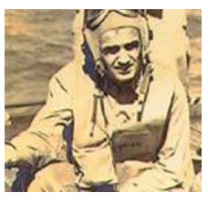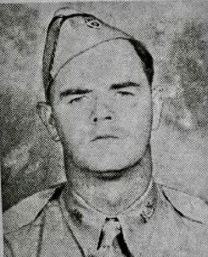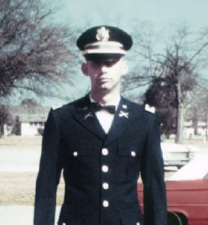The following is an edited excerpt of the life narrative that will be read during the 2023 Gold Star Hall Ceremony.

Alfred Hiram Agan
Alfred Hiram Agan was born in Chariton Point on July 6, 1919, to Samuel and Alda Agan, the fourth child, following older siblings, Maxine, Norma and Donald. Alfred graduated from Chariton High and was a participant and representative of the band throughout.
The whole family was very engaged in the community and was active in the Episcopal Church in town. Church records from 1932, indicate that Alfred spent a handful of years as a Des Moines Register and Tribune carrier salesman in Chariton, interacting with community members and providing important news and information. He was awarded a college scholarship in 1937 through the Tribune for having outstanding high school studies, citizenship and business efficiency.
In 1945, Alfred married Mary Louise Mann Morgan, who was originally from Sigourney, though the two met in Chariton. Alfred and Mary had two sons, Frederick in 1946 and Richard in 1949.
Alfred entered the military in December 1942, serving in the Marine Corps as a pilot in the Pacific Theatre all the way through World War II. For his first assignment, he flew a Marine torpedo bomber in the Central Solomons. He was charged in hazardous aerial mine-laying operations on Japanese harbors. Agan was then stationed on the aircraft carrier Essex. Captain Agan was the first Marine pilot to use a proximity fuse, a fuse that detonates an explosive device automatically when it is within a certain distance from its target. As a member of the first carrier-based Marine air unit of the war, he was among those of the Navy force that struck Tokyo on three occasions. He was recognized as being with one of the first groups to bomb the Japanese Islands and was awarded two air medals.
After his initial discharge in 1945, he was able to return to school. From the years 1945 to 1948, Agan attended Iowa State and graduated with a bachelor’s degree in architectural engineering. In the 1948 edition of “The Bomb,” Iowa State’s yearbook, he is listed as part of the American Institute of Architects Student Organization. The group's Fun House booth at the Engineers’ Carnival took second place honors. Besides helping with VEISHEA’s open house displays, the organization also held an annual spring picnic for members and their guests.
After graduation, Alfred found himself in San Diego and was employed by an architectural firm prior to his re-enlistment for the Korean War. He was a captain in the Marine Corps Reserve at this time. Only three weeks into the war, he was called back in September of 1950 to serve. Mary and the two boys went to live with her parents back in Chariton while he was on active duty.
When called back, Alfred became the pilot of an F4U-4 Corsair fighter with Marine Fighter Squadron 212, Marine Air Group 12 on the aircraft carrier USS Bataan (CVL-29). His squadron was famously known as the “Black Sheep” squadron; it included pilots who were some of the most experienced in the South Pacific.
On the night of Jan. 19, 1951, as Agan was returning from a routine flight he had to stop at a field that was not his own as his plane was disabled. He was advised to fly to Japan where the plane could be serviced. It was not known whether the plane had been damaged by enemy fire or not at the time. While flying against the enemy on Jan. 20 in an attempt to reach Japan, he was forced to evacuate his plane as it was failing to respond properly. The plane sank immediately in the sea as he was just 11 miles south of Incheon, Korea. Captain Agan was seen after the sinking, alive and with his life jacket inflated. But when a rescue plane arrived an hour later, the crew found he had not survived. It is believed that he was injured when he evaded his plane.
His death is officially listed as Jan. 20, 1951, in South Korea. He was 31 years old. At the time of Alfred’s death, his son Frederic was 5 and Richard was only 2 – both were too young to have strong recollection of their father. Alfred’s wife, Mary, had earned her bachelor’s at Iowa State while Alfred first was called to duty and later studied for her master’s at the University of Illinois Urbana. Throughout her life, she held many professional positions. She was a graphic designer for an aircraft company, a real estate agent, a public school art instructor and her last position was an art education professor at Iowa State University.
Much of Alfred’s heart remains in his hometown of Chariton, though he is memorialized at Fort Rosecrans National Cemetery outside San Diego where he is buried, a National American Cemetery administered through the Department of Veteran’s Affairs.
Agan is also remembered at the Korean War Veterans Memorial in Washington, D.C. Captain Agan was awarded various medals, including the Purple Heart, the National Defense Service Medal and the Marine Corps Good Conduct Medal.
Alfred Agan is one among a group of approximately 200,000 soldiers who served in both World War II and Korea. These soldiers are often referred to as “double veterans,” and they faced unique challenges when called out of civilian life as older adults to return to military service. And yet, Agan and his comrades answered the call to service and the call to help defend the freedoms of an important ally.

